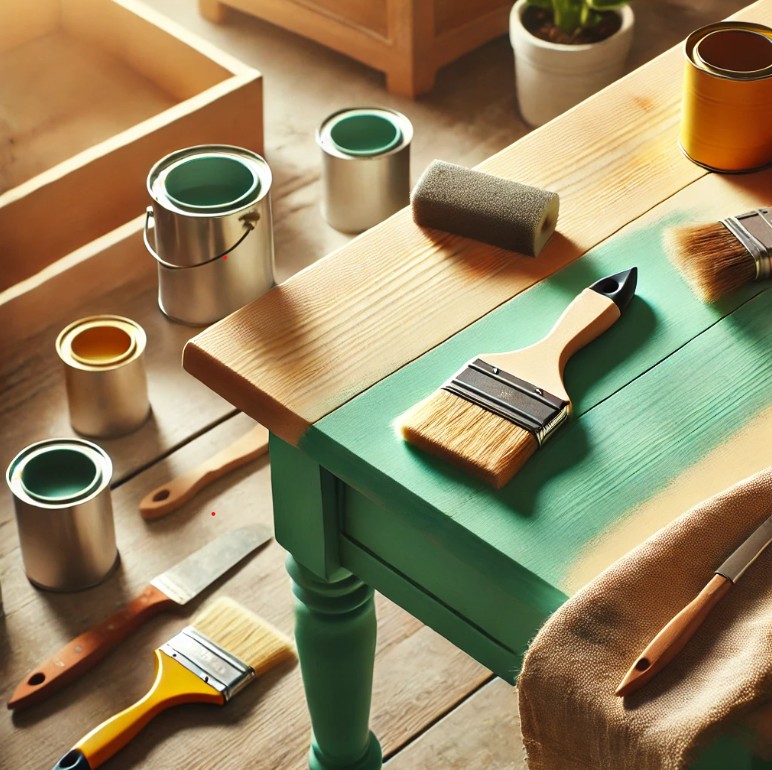Ever started painting a piece of furniture only to end up with brush marks, bumps, or uneven spots?
I’ve been there, and trust me, it doesn’t have to be that way.
With the right steps and tools, you can achieve a smooth, professional-looking finish on any piece of furniture.
Let’s break it down.
Step 1: Prep Like a Pro
Before you even think about picking up a paintbrush, prep your furniture.
This is the step that makes or breaks your finish.
- Clean the furniture:
- Use a damp cloth and mild soap to remove dirt, grease, or old residue.
- Let it dry completely.
- Sand it down:
- Use medium-grit sandpaper (around 120 grit) to remove any old finish or gloss.
- Wipe off the dust with a tack cloth or a damp microfiber cloth.
- Fix imperfections:
- Fill any scratches or dents with wood filler.
- Sand the filler once it’s dry, and smooth the surface again.
- Prime it:
- Apply a quality primer to create a smooth base.
- Use a small roller or brush for an even coat.
- Let the primer dry, then lightly sand with fine-grit sandpaper (around 220 grit).
Step 2: Pick the Right Tools
The tools you use can make or break your finish.
- Brush: Choose a high-quality synthetic brush for water-based paints and a natural bristle brush for oil-based paints.
- Roller: A foam roller is great for flat, even surfaces.
- Paint sprayer: If you want a flawless finish with minimal effort, a sprayer is a game-changer.
Don’t skimp on tools—it’s worth the investment.
Step 3: Choose the Right Paint
Not all paint is created equal, and furniture deserves the good stuff.
- Use enamel paint: It dries harder and gives a smoother finish.
- Go for satin or semi-gloss: These finishes hide imperfections better and are easier to clean.
Step 4: Apply Thin Coats
Here’s where most people mess up—they slap on thick coats of paint.
Instead:
- Stir your paint thoroughly to avoid uneven color.
- Apply thin coats with a brush, roller, or sprayer.
- Let each coat dry completely (check the can for drying times).
- Lightly sand between coats with 320-grit sandpaper for a buttery smooth surface.
Step 5: Finish with a Topcoat
A topcoat protects your paint and gives it a polished look.
- Pick the right topcoat: Polyurethane for durability or polycrylic for a clear, non-yellowing finish.
- Apply with care: Use a clean brush or foam roller to avoid bubbles.
- Let it cure fully before heavy use (usually a few days).
FAQs – How to Paint Furniture to Get a Smooth Finish
Q: Do I really need to sand the furniture?
Yes! Sanding helps paint stick and smoothens out any flaws in the surface.
Q: What if I don’t have a primer?
Skipping primer is risky. Without it, your paint might not adhere well or could peel over time.
Q: How do I avoid brush strokes?
Use thin, even coats and a high-quality brush. For a flawless finish, consider a paint sprayer.
Q: Can I paint laminate furniture?
Yes! Just use a bonding primer and follow the same steps.
Other Interesting Articles
- What’s the Difference Between Gymnastics and Tumbling?
- What’s the Difference Between Baptist and Church of Christ?
- What’s the Difference Between Atlas and Atlas Cross Sport?
- What is the Difference Between Judo and Jiu-Jitsu?
- Atari Lynx: Difference Between Lyx or Lnx
Final Thoughts
Learning how to paint furniture to get a smooth finish doesn’t have to feel overwhelming.
It’s all about prep, patience, and using the right tools.
Start with small projects, and soon you’ll be turning out furniture that looks like it came straight from a showroom.
About the Author
HowDiff
We’re all about breaking down tough topics into simple, actionable steps. When it comes to painting furniture or comparing the finer details, we’ve got you covered.
